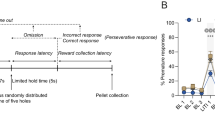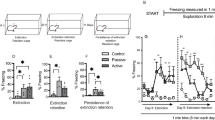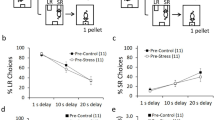Abstract
The selective breeding of Roman high- (RHA) and low-avoidance (RLA) rats for rapid vs extremely poor acquisition of active avoidance behavior in a shuttle-box has generated two phenotypes with different emotional and motivational profiles. The phenotypic traits of the Roman rat lines/strains (outbred or inbred, respectively) include differences in sensation/novelty seeking, anxiety/fearfulness, stress responsivity, and susceptibility to addictive substances. We designed this study to characterize differences between the inbred RHA-I and RLA-I strains in the impulsivity trait by evaluating different aspects of the multifaceted nature of impulsive behaviors using two different models of impulsivity, the delay-discounting task and five-choice serial reaction time (5-CSRT) task. Previously, rats were evaluated on a schedule-induced polydipsia (SIP) task that has been suggested as a model of obsessive-compulsive disorder. RHA-I rats showed an increased acquisition of the SIP task, higher choice impulsivity in the delay-discounting task, and poor inhibitory control as shown by increased premature responses in the 5-CSRT task. Therefore, RHA-I rats manifested an increased impulsivity phenotype compared with RLA-I rats. Moreover, these differences in impulsivity were associated with basal neurochemical differences in striatum and nucleus accumbens monoamines found between the two strains. These findings characterize the Roman rat strains as a valid model for studying the different aspects of impulsive behavior and for analyzing the mechanisms involved in individual predisposition to impulsivity and its related psychopathologies.
Similar content being viewed by others
Log in or create a free account to read this content
Gain free access to this article, as well as selected content from this journal and more on nature.com
or
References
Aguilar R, Gil L, Gray JA, Driscoll P, Flint J, Dawson GR et al. (2003). Fearfulness and sex in F2 Roman rats: males display more fear though both sexes share the same fearfulness traits. Physiol Behav 78: 723–732.
American Psychiatric Association (2000). Diagnostic and Statistical Manual of Mental Disorders 4th edn, text revision. American Psychiatric Press: Washington, DC.
Anderson KG, Woolverton WL (2005). Effects of clomipramine on self-control choice in Lewis and Fischer 344 rats. Pharmacol Biochem Behav 80: 387–393.
Annetrude JG, de Mooij-van Malsen A, Berend Olivier AB, Martien JHK (2008). Behavioural genetics in mood and anxiety: a next step in finding novel pharmacological targets. Eur J Pharmacol 585: 436–440.
Aubry JM, Bartanusz V, Driscoll P, Schulz P, Steimer T, Kiss Jz (1995). Corticotropin-releasing factor and vasopressin mRNA levels in Roman high- and low-avoidance rats: response to open-field exposure. Neuroendocrinology 61: 89–97.
Broadhurst PL, Bignami G (1965). Correlative effects of psychogenetic selection: a study of the Roman high and low avoidance strains of rats. Behav Res Ther 3: 273–280.
Cardinal RN, Pennicott DR, Sugathapala CL, Robbins TW, Everitt BJ (2001). Impulsive choice induced in rats by lesions of the nucleus accumbens core. Science 292: 2499–2501.
Cardona D, López-Grancha M, López-Crespo G, Nieto-Escamez F, Sánchez-Santed F, Flores P (2006). Vulnerability of long-term neurotoxicity of chlorpyrifos: effect on schedule-induced polydipsia and a delay discounting task. Psychopharmacology 189: 47–57.
Carli M, Robbins TW, Evenden JL, Everitt BJ (1983). Effects of lesions to ascending noradrenergic neurones on performance of a 5-choice serial reaction task in rats; implications for theories of dorsal noradrenergic bundle function based on selective attention and arousal. Behav Brain Res 9: 361–380.
Carrasco J, Márquez C, Nadal R, Tobeña A, Fernández-Teruel A, Armario A (2008). Characterization of central and peripheral components of the hypothalamus-pituitary-adrenal axis in the inbred Roman rat strains. Psychoneuroendocrinology 33: 437–445.
Chakroun N, Doron J, Swendsen J (2004). Substance use, affective problems and personality traits: test of two association models. Encephale 30: 564–569.
Charnay Y, Steimer T, Huguenin C, Driscoll P (1995). [3H] Paroxetine binding sites: brain regional differences between two psychogenetically selected lines of rats. Neurosci Res Comm. 16: 29–35.
Corda MG, Piras G, Lecca D, Fernández-Teruel A, Driscoll P, Giorgi O (2005). The psychogenetically selected Roman rat lines differ in the susceptibility to develop amphetamine sensitization. Behav Brain Res 157: 147–156.
Crabbe JC (2002). Genetic contributions to addiction. Annu Rev Psychol 53: 435–462.
Dalley JW, Mar AC, Economidou D, Robbins TW (2008). Neurobehavioral mechanisms of impulsivity: fronto-striatal systems and functional neurochemistry. Pharmacol Biochem Behav 90: 250–260.
Dalley JW, Theobald DE, Pereira EA, Li PM, Robbins TW (2002). Specific abnormalities in serotonin release in the prefrontal cortex of isolation-reared rats measured during behavioural performance of a task assessing visuospatial attention and impulsivity. Psychopharmacology 164: 329–340.
Daruna JH, Barnes PA (1993). A neurodevelopmental view of impulsivity. In: McCown WG, Johnson JL, Shure MB (eds). The Impulsive Client: Theory, Research and Treatment. American Psychological Association: Washington DC. pp 23–37.
Driscoll P, Bättig K (1982). Behavioural, emotional and neurochemical profiles of rats selected for extreme differences in active, two-way avoidance performance. In: Lieblich I (ed). Genetics of the Brain. Elsevier: Amsterdam. pp 95–123.
Driscoll P, Dedek J, D’Angio M, Claustre Y, Scatton B (1990). A genetically-based model for divergent stress response: behavioral, neurochemical and hormonal aspects. In: Pliska V, and Stranzinger G (eds). Farm Animals in Biomedical Research, vol. 5. Verlay Paul Parey: Hamburg, pp 97–107.
Driscoll P, Dedek J, Martin JR, Baettig K (1980). Regional 5-HT analysis in Roman high- and low-avoidance rats following MAO inhibition. Eur J Pharmacol 68: 373–376.
Driscoll P, Escorihuela RM, Fernández-Teruel A, Giorgi O, Schwegler H, Steimer TH et al. (1998). Genetic selection and differential stress responses: the Roman lines/strain of rats. In: Csermely P (ed). Stress of Life: From Molecules to Man. New York Academy of Sciences: New York. pp 501–510.
Driscoll P, Fernández-Teruel A, Corda MG, Giorgi O, Steimer T (2009). Some guidelines for defining personality differences in rats. In: Kim YK (ed). Handbook of Behavior Genetics. Springer: New York. pp 281–300.
Escorihuela RM, Fernández-Teruel A, Gil L, Aguilar R, Tobeña A, Driscoll P (1999). Inbred Roman high- and low-avoidance rats: differences in anxiety, novelty-seeking, and shuttlebox behaviors. Physiol Behav 67: 19–26.
Escorihuela RM, Fernández-Teruel A, Tobeña A, Langhans W, Bättig K, Driscoll P (1997). Labyrinth exploration, emotional reactivity, and conditioned fear in young Roman/Verh inbred rats. Behav Genet 27: 573–578.
Escorihuela RM, Tobeña A, Driscoll P, Fernández-Teruel A (1995). Effects of training, early handling, and perinatal flumazenil on shuttle box acquisition in Roman low-avoidance rats: toward overcoming a genetic deficit. Neurosci Biobehav Rev 19: 353–367.
Evenden JL (1999). Varieties of impulsivity. Psychopharmacology 146: 413–421.
Evenden JL, Ryan CN (1996). The pharmacology of impulsive behaviour in rats: the effects of drugs on response choice with varying delays of reinforcement. Psychopharmacology 128: 161–170.
Fattore L, Piras G, Corda MG, Giorgi O (2009). The Roman high- and low-avoidance rat lines differ in the acquisition, maintenance, extinction, and reinstatement of intravenous cocaine self-administration. Neuropsychopharmacology 34: 1091–1101.
Falk JL (1961). Production of polydipsia in normal rats by an intermittent food schedule. Science 133: 195–196.
Fernández-Teruel A, Escorihuela RM, Castellano B, González B, Tobeña A (1997). Neonatal handling and environmental enrichment effects on emotionality, novelty/reward seeking, and age-related cognitive and hippocampal impairments: focus on the Roman rat lines. Behav Genet 27: 513–526.
Fernández-Teruel A, Escorihuela RM, Núñez JF, Gomà M, Driscoll P, Tobeña A (1992). Early stimulation effects on novelty-induced behavior in two psychogenetically-selected rat lines with divergent emotionality profiles. Neurosci Lett 137: 185–188.
Fernández-Teruel A, Driscoll P, Gil L, Aguilar R, Tobeña A, Escorihuela RM (2002a). Enduring effects of environmental enrichment on novelty seeking, saccharin and ethanol intake in two rat lines (RHA/Verh and RLA/Verh) differing in incentive-seeking behavior. Pharmacol Biochem Behav 73: 225–231.
Fernández-Teruel A, Giménez-Llort L, Escorihuela RM, Gil L, Aguilar R, Steimer T et al. (2002b). Early-life handling stimulation and environmental enrichment: are some of their effects mediated by similar neural mechanisms? Pharmacol Biochem Behav 73: 233–245.
Ferre P, Fernández-Teruel L, Escorihuela RM, Driscoll P, Corda MG, Giorgi O et al. (1995). Behavior of the Roman/very high- and low-avoidance rat lines in anxiety tests: relationship with defecation and self-grooming. Physiol Behav 58: 1209–1213.
Gentsch C, Lichtsteiner M, Feer H (1991). Genetic and environmental influences on reactive and spontaneous locomotor activities in rats. Experientia 47: 998–1008.
Gilpin NW, Badia-Elder NE, Elder RL, Stewart RB (2008). Schedule-induced polydipsia in lines of rats selectively bred for high and low ethanol preference. Behav Genet 38: 515–524.
Giménez-Llort L, Cañete T, Guitart-Masip M, Fernández-Teruel A, Tobeña A (2005). Two distinctive apomorphine-induced phenotypes in the Roman high- and low-avoidance rats. Physiol Behav 86: 458–466.
Giorgi O, Lecca D, Piras G, Driscoll P, Corda MG (2003). Dissociation between mesocortical dopamine release and fear-related behaviours in two psychogenetically selected lines of rats that differ in coping strategies to aversive conditions. Eur J Neurosci 17: 2716–2726.
Giorgi O, Orlandi M, Escorihuela RM, Driscoll P, Lecca D, Corda MG (1994). GABAergic and dopaminergic transmission in the brain of Roman high-avoidance and Roman low-avoidance rats. Brain Res 638: 133–138.
Giorgi O, Piras G, Corda MG (2007). The psychogenetically selected Roman high- and low-avoidance rat lines: a model to study the individual vulnerability to drug addiction. Neurosci Biobehav Rev 31: 148–163.
Gould TD, Gottesman II (2006). Psychiatric endophenotypes and the development of valid animal models. Genes Brain Behav 5: 113–119.
Guitart-Masip M, Giménez-Llort L, Fernández-Teruel A, Cañete T, Tobeña A, Ogren SO et al. (2006a). Reduced ethanol response in the alcohol-preferring RHA rats and neuropeptide mRNAs in relevant structures. Eur J Neurosci 23: 531–540.
Guitart-Masip M, Johansson B, Cañete T, Fernández-Teruel A, Tobeña A, Terenius L et al. (2008a). Regional adaptations in PSD-95, NGFI-A and secretogranin gene transcripts related to vulnerability to behavioral sensitization to amphetamine in the Roman rat strains. Neuroscience 151: 195–208.
Guitart-Masip M, Johansson B, Fernández-Teruel A, Cañete T, Tobeña A, Terenius L et al. (2006b). Divergent anatomical pattern of D1 and D3 binding and dopamine- and cyclic AMP-regulated phosphoprotein of 32 kDa mRNA expression in the Roman rat strains: implications for drug addiction. Neuroscience 142: 1231–1243.
Guitart-Masip M, Johansson B, Fernández-Teruel A, Tobeña A, Giménez-Llort L. (2008b). Divergent effect of the selective D3 receptor agonist pd-128,907 on locomotor activity in Roman high- and low-avoidance rats: relationship to NGFI-A gene expression in the Calleja islands. Psychopharmacology 196: 39–49.
Harrison AA, Everitt BJ, Robbins TW (1997). Central 5-HT depletion enhances impulsive responding without affecting the accuracy of attentional performance: interactions with dopaminergic mechanisms. Psychopharmacology 133: 329–342.
Kosten TA, Ambrosio E (2002). HPA axis function and drug addictive behaviors: insights from studies with Lewis and Fischer 344 inbred rats. Psychoneuroendocrinology 27: 35–69.
Kreek MJ, Nielsen DA, Butelman ER, LaForge KS (2005). Genetic influences on impulsivity, risk taking, stress responsivity and vulnerability to drug abuse and addiction. Nat Neurosci 8: 1450–1457.
Kulikov A, Castanon N, Morméde P, Chaouloff F (1995). Cerebral tryptophan hydroxylase activity, and 5-HT1A receptor, 5-HT2A receptor, and 5-HT transporter binding in grouped and isolated Roman RHA an RLA rats: relationships with behaviours in two models of anxiety. Psychopharmacology 121: 385–395.
Laakso A, Mohn AR, Gainetdinov RR, Caron MG (2002). Experimental genetic approaches to addiction. Neuron 36: 213–228.
Lecca D, Piras G, Driscoll P, Giorgi O, Corda MG (2004). A differential activation of dopamine output in the shell and core of the nucleus accumbens is associated with the motor responses to addictive drugs: a brain dialysis study in Roman high- and low-avoidance rats. Neurochopharmacology 46: 688–699.
López-Aumatell R, Blázquez G, Gil L, Aguilar R, Cañete T, Giménez-Llort L et al. (2009a). The Roman high- and low-avoidance rat strains differ in fear-potentiated startle and classical aversive conditioning. Psicothema 21: 27–32.
López-Aumatell R, Vicens-Costa E, Guitart-Masip M, Martinez-Membrives E, Valdar W, Johannesson M et al. (2009b). Unlearned anxiety predicts learned fear: a comparison among heterogeneous rats and the Roman rat strains. Behav Brain Res 202: 92–101.
López-Grancha M, López-Crespo G, Sánchez-Amate MC, Flores P (2008). Individual differences in schedule-induced polydipsia and the role of gabaergic and dopaminergic systems. Psychopharmacology 197: 487–498.
Machado-Vieira R, Kapczinski F, Soares JC (2004). Perspectives for the development of animal models of bipolar disorder. Prog Neuropsychopharmacol Biol Psychiatry 28: 209–224.
Mittleman G, Valenstein E (1984). Ingestive behavior evoked by hypothalamic stimulation and schedule-induced polydipsia are related. Science 224: 415–417.
Mittleman G, Valenstein E (1985). Individual differences in non-regulatory ingestive behavior and catecholamine systems. Brain Res 348: 112–117.
Mittleman G, Van Brunt CL, Matthews DB (2003). Schedule-induced ethanol self-administration in DBA/2J and C57BL/6J mice. Alcohol Clin Exp Res 27: 918–925.
Moreno M, Cañadas F, Cardona D, Flores P, Suñol C, Campa L et al. (2008). Long-term monoamine alteration in striatum and nucleus accumbens after acute Chlorpyrifos exposure. Toxicol Letters 176: 162–167.
Moreno M, Ruedas L, Flores P (2009). Vulnerability differences in binge-eating behavior after schedule induced polydipsia. Behav Pharmacol 20: S38.
Piazza PV, Mittleman G, Deminiere JM, Le Moal M, Simon H (1993). Relationship between schedule-induced polydipsia and amphetamine intravenous self-administration. Individual differences and role of experience. Behav Brain Res 55: 185–193.
Platt B, Beyer CE, Schechter LE, Rosenzweig-Lipson S (2008). Schedule-induced polydipsia: a rat model of obsessive-compulsive disorder. Curr Protoc Neurosci 9: 1–7.
Puumala T, Sirviö J (1998). Changes in activities of dopamine and serotonin systems in the frontal cortex underlie poor choice accuracy and impulsivity of rats in an attention task. Neuroscience 83: 489–499.
Robbins TW (2002). The 5-choice serial reaction time task: behavioural pharmacology and functional neurochemistry. Psychopharmacology 163: 362–380.
Robinson ES, Eagle DM, Economidou D, Theobald DE, Mar AC, Murphy ER et al. (2009). Behavioural characterisation of high impulsivity on the 5-choice serial reaction time task: specific deficits in ‘waiting’ versus ′stopping′. Behav Brain Res 196: 310–316.
Rosas JM, Callejas-Aguilera JE, Escarabajal MD, Gomez MJ, de la Torre L, Agüero A et al. (2007). Successive negative contrast effect in instrumental runway behaviour: a study with Roman high- (RHA) and Roman low- (RLA) avoidance rats. Behav Brain Res 185: 1–8.
Rosenzweig-Lipson S, Sabb A, Snack G, Mitchell P, Lucki I, Malberg JE et al. (2007). Antidepressant-like effects of the novel, selective, 5-HT2C receptor agonist WAY-163909. Psychopharmacology 192: 159–170.
Sánchez-Cardoso P, Higuera-Matas A, Martín S, Miguéns M, Del Olmo N, García-Lecumberri C et al. (2009). Strain differences between Lewis and Fischer 344 rats in the modulation of dopaminergic receptors after morphine self-administration and during extinction. Neuropharmacology 57: 8–17.
Semenova S, Markou A (2007). The effects of the mGluR5 antagonist MPEP and the mGluR2/3 antagonist LY341495 on rats’ performance in the 5-choice serial reaction time task. Neuropharmacology 52: 863–872.
Semenova S, Stolerman IP, Markou A (2007). Chronic nicotine administration improves attention while nicotine withdrawal induces performance deficits in the 5-choice serial reaction time task in rats. Pharmacol, Biochem Behav 87: 360–368.
Sher KJ, Bartholow BD, Wood MD (2000). Personality and substance use disorders: a prospective study. J Consult Clin Psychol 68: 818–829.
Steimer T, Driscoll P (2003). Divergent stress responses and coping styles in psychogenetically selected Roman high-(RHA) and low-(RLA) avoidance rats: behavioural, neuroendocrine and developmental aspects. Stress 6: 87–100.
Steimer T, Driscoll P (2005). Inter-individual vs line/strain differences in psychogenetically selected Roman High-(RHA) and Low-(RLA) Avoidance rats: neuroendocrine and behavioural aspects. Neurosci Biobehav Rev 29: 99–112.
Toscano CA, Kameyama M, Garcia-Mijares M, Silva MT, Santarem EM (2008). Relationship between ethanol and sucrose self-administration and schedule-induced polydipsia. Pharmacol Biochem Behav 90: 586–589.
van Gaalen MM, Brueggeman RJ, Bronius PF, Schoffelmeer AN, Vanderschuren LJ (2006). Behavioral disinhibition requires dopamine receptor activation. Psychopharmacology 187: 73–85.
Winstanley C, Dalley J, Theobald D, Robbins T (2004). Fractionating impulsivity: contrasting effects of central 5-HT depletion on different measures if impulsive behaviour. Neuropsychopharmacology 29: 1331–1343.
Winstanley CA, Eagle DM, Robbins TW (2006). Behavioral models of impulsivity in relation to ADHD: translation between clinical and preclinical studies. Clin Psychol Rev 26: 379–395.
Woods A, Smith C, Szewczak M, Dunn RW, Cornfeldt M, Corbett R (1993). Selective serotonin re-uptake inhibitors decrease schedule-induced polydipsia in rats: a potential model for obsessive compulsive disorder. Psychopharmacology 112: 195–198.
Woods-Kettelberger AT, Smith CP, Corbett R, Szewczak MR, Roehr JE, Bores GM et al. (1996). Besipirdine (HP 749) reduces schedule-induced polydipsia in rats. Brain Res Bull 41: 125–130.
Zeier H, Baettig K, Driscoll P (1978). Acquisition of DRL-20 behavior in male and female, Roman high- and low-avoidance rats. Physiol Behav 20: 791–793.
Acknowledgements
This work was supported by project SEJ2006-15226-C0201/PSIC, granted by the Ministerio de Ciencia e Innovación, subdirección general de proyectos de investigación and by FEDER funds. AF-T and AT receive support from EURATools (European Commission Contract no. LSHG-CT-2005-019015), PSI2009-10532, and 2009-SGR-51. We thank A Cañete and L Ruedas for their invaluable and continuous help.
Author information
Authors and Affiliations
Corresponding author
Ethics declarations
Competing interests
The authors declare no conflict of interest.
Rights and permissions
About this article
Cite this article
Moreno, M., Cardona, D., Gómez, M. et al. Impulsivity Characterization in the Roman High- and Low-Avoidance Rat Strains: Behavioral and Neurochemical Differences. Neuropsychopharmacol 35, 1198–1208 (2010). https://doi.org/10.1038/npp.2009.224
Received:
Revised:
Accepted:
Published:
Issue date:
DOI: https://doi.org/10.1038/npp.2009.224
Keywords
This article is cited by
-
Noradrenergic regulation of cue-guided decision making and impulsivity is doubly dissociable across frontal brain regions
Psychopharmacology (2024)
-
The development of compulsive coping behaviour is associated with a downregulation of Arc in a Locus Coeruleus neuronal ensemble
Neuropsychopharmacology (2023)
-
Reduced Expression of the Htr2a, Grin1, and Bdnf Genes and Cognitive Inflexibility in a Model of High Compulsive Rats
Molecular Neurobiology (2023)
-
Cumulative Genetic Score of DRD2 Polymorphisms Is Associated with Impulsivity and Masked Semantic Priming
Journal of Molecular Neuroscience (2022)
-
Early environmental enrichment and impoverishment differentially affect addiction-related behavioral traits, cocaine-taking, and dopamine D2/3 receptor signaling in a rat model of vulnerability to drug abuse
Psychopharmacology (2021)



